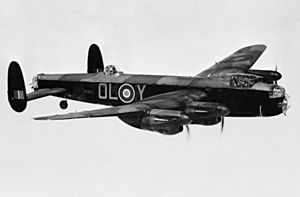No. 83 Squadron RAF facts for kids
Quick facts for kids No. 83 Squadron RAF |
|
|---|---|
| Active | 7 January 1917 – 31 December 1919 4 August 1936 – 31 December 1955 21 May 1957 – 31 August 1969 |
| Country | |
| Branch | Royal Flying Corps (1917–1918) |
| Role | Bomber |
| Motto(s) | "Strike to Defend" |
| Insignia | |
| Squadron badge heraldry | An attire, sable.The red deer's antler is in reference to the squadron's association with Scotland. The attire has six points commemorating an outstanding occasion in the First World War when six DFCs were awarded for one extremely valuable reconnaissance operation -successfully completed by six individuals in three aircraft during 14/15 June 1918. They were the only Allied aircraft in the air in weather which had grounded all others. The antler in black affords reference to night flying and the three top points stand for the crown of success met with by the squadron. |
| Squadron codes | QQ Allocated Nov 1938 - Sep 1939 OL Sep 1939 - Apr 1951 AS To be used for visit to Chile in 1946, changed to GB GB Used on aircraft for visit to Chile - October 1946 |
| Aircraft flown | |
| Bomber | FE2b, FE2d (1917–1919) Hawker Hind (1936–1938) Handley Page Hampden (1938–1941) Avro Manchester (1941–1942) Avro Lancaster (1942–1945) Avro Lincoln (1946–1955) Avro Vulcan (1957–1969) |
No. 83 Squadron RAF was a special group of pilots and aircrew who flew planes for the United Kingdom. They were part of the Royal Flying Corps and later the Royal Air Force. This squadron was active for many years, from 1917 all the way to 1969. They played important roles in both the First World War and the Second World War, flying different types of aircraft.
Contents
The Start of 83 Squadron
No. 83 Squadron was first formed on January 7, 1917, in Montrose. The pilots and crew trained at places like RAF Spitalgate and RAF Wyton. They learned to fly Royal Aircraft Factory F.E.2 planes, which were used for bombing at night.
In March 1918, the squadron moved to France. Their job was to bomb German troop groups to stop a big German attack. For the rest of the war, they flew night bombing missions, mostly targeting railway lines. They also flew reconnaissance missions, which means they gathered information by flying over enemy areas. The squadron was then closed down on December 31, 1919.
Reforming for World War II

The squadron started up again on August 4, 1936, in RAF Turnhouse, Scotland. They flew Hawker Hind planes for bombing during the day. In 1938, they moved to RAF Scampton and began using Handley Page Hampden planes.
Early Missions and a Hero
No. 83 Squadron was one of the first to act when the Second World War began. On the very first day, they flew over the North Sea looking for German warships. They continued to attack German ships and coastal targets. However, flying missions during the day became too dangerous. So, the Royal Air Force's Bomber Command switched to flying missions mostly at night.
In late 1940, the squadron attacked ships that were gathering in Channel Ports, which were preparing for an invasion. During a raid on Antwerp on September 15, 1940, something amazing happened. Flight Sergeant John Hannah, who was a wireless operator and gunner, was awarded the Victoria Cross. This is a very brave award. He earned it for putting out a serious fire on his plane, even though he was badly burned.
In December 1941, the squadron got new planes called Avro Manchesters. But these planes had engines that were not powerful enough and often broke down. So, they were quickly replaced with the famous Avro Lancaster bombers.
Becoming a Pathfinder Squadron
In August 1942, No. 83 Squadron joined the Pathfinder Force at RAF Wyton. Their new job was to be "Pathfinders." This meant they would fly ahead of the main bomber force. They would mark targets with flares so the other bombers knew exactly where to drop their bombs. This made the bombing missions much more accurate.
In April 1944, 83 Squadron moved to RAF Coningsby. Here, they continued their role as Pathfinders for their own group's special missions.

In May 1946, the squadron started using Avro Lincoln planes. They moved to RAF Hemswell in October. In September 1953, they went to Singapore. There, they flew bombing missions during the Malayan Emergency, targeting places where Communist rebels were thought to be hiding. They returned to Hemswell in January 1954 and stayed there until the squadron was closed down again in December 1955.
After World War II
In May 1957, the squadron was formed again at RAF Waddington. They became the very first RAF squadron to fly the Avro Vulcan bomber. This was a very advanced jet bomber.
In August 1960, they gave their first Vulcan planes to another squadron. Then, they moved to RAF Scampton and became the first squadron to get the newer Vulcan Mk2 planes. These planes first carried Yellow Sun nuclear weapons. Later, they were armed with Blue Steel stand-off bombs, which could be launched from a distance. The squadron stayed at Scampton until it was finally closed down in August 1969.



